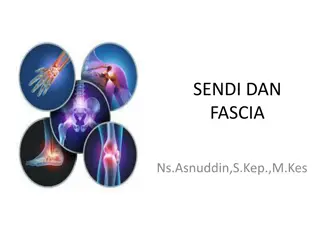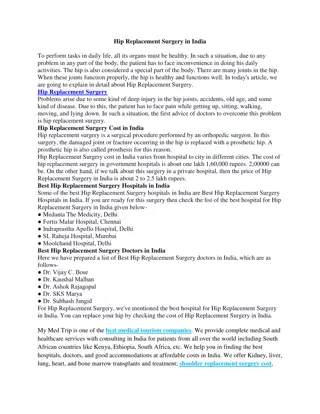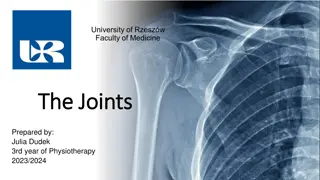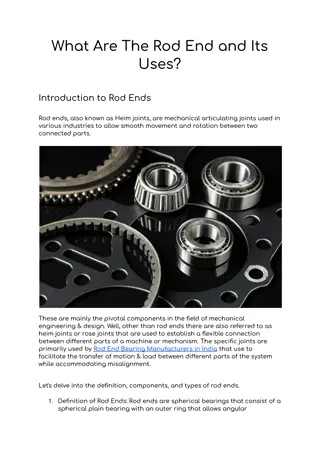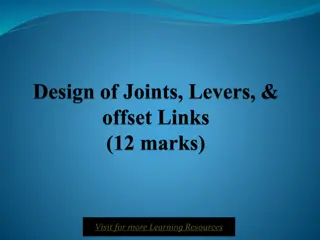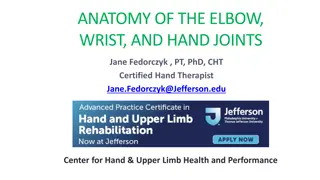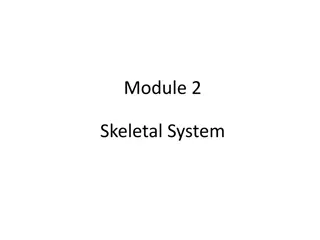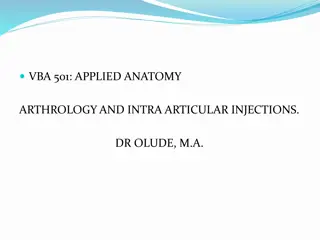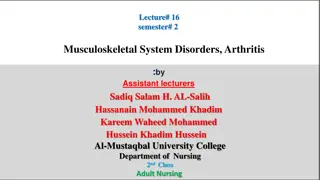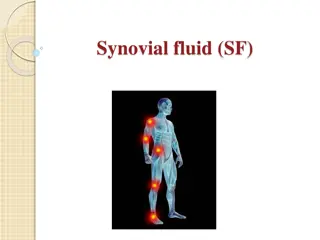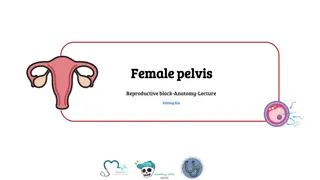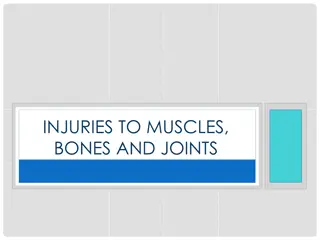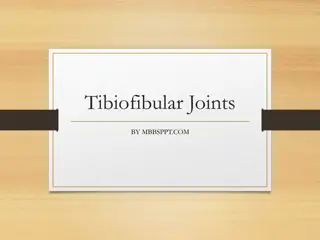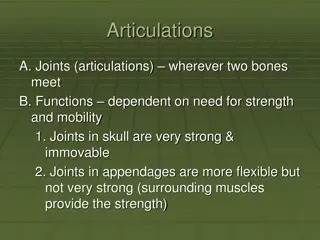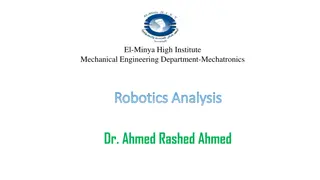Rigid Pavement Design: Stresses and Joint Types
Stresses due to temperature variation can affect concrete slabs, causing warping and friction stresses. Proper joint design, including expansion, contraction, and construction joints, is crucial to minimize stress and prevent warping in concrete pavements. This guide explores different types of join
4 views • 9 slides
BRIDGE EXPANSION JOINT
Bridge expansion joints are crucial components that provide continuity between different parts of bridge structures, accommodating movements caused by various factors like thermal deformation and traffic loads. They come in different types based on movement ranges and construction methods, such as s
5 views • 34 slides
Understanding Types of Joints in the Human Body
Joints are crucial points where bones meet, enabling movement and stability in the body. They can be classified into different types based on their structure, including Fibrous Joints, Cartilaginous Joints, and Synovial Joints. Each type serves unique functions in supporting bodily movements.
3 views • 27 slides
Hip Replacement Surgery in India
To perform tasks in daily life, all its organs must be healthy. In such a situation, due to any problem in any part of the body, the patient has to face inconvenience in doing his daily activities. The hip is also considered a special part of the body. There are many joints in the hip. When these jo
3 views • 2 slides
Understanding Joints and Their Classification in the Human Body
Joints are pivotal in allowing movement and providing structure in the human body. Learn about the construction of synovial joints, range of motion, and various joint classifications based on mobility and structure such as ball and socket, hinge, and more. Explore the functions and significance of j
3 views • 17 slides
What Are The Rod End and Its Uses
Rod ends, also known as Heim joints, are mechanical articulating joints used in various industries to allow smooth movement and rotation between two connected parts.
0 views • 3 slides
Understanding Cotter Joints in Mechanical Engineering
Explore the applications, design criteria, and failure modes associated with cotter joints in mechanical systems. Learn about the design procedure, thickness determination, and various types of cotter joints. Discover how cotter joints play a crucial role in connecting components in machinery, ensur
1 views • 30 slides
Understanding Classification Keys for Identifying and Sorting Things
A classification key is a tool with questions and answers, resembling a flow chart, to identify or categorize things. It helps in unlocking the identification of objects or living things. Explore examples like the Liquorice Allsorts Challenge and Minibeast Classification Key. Also, learn how to crea
1 views • 6 slides
Basics of Fingerprinting Classification and Cataloguing
Fingerprint classification is crucial in establishing a protocol for search, filing, and comparison purposes. It provides an orderly method to transition from general to specific details. Explore the Henry Classification system and the NCIC Classification, and understand why classification is pivota
5 views • 18 slides
Understanding the Anatomy of Elbow, Wrist, and Hand Joints
Explore the intricate anatomy of the elbow complex, wrist, and hand joints through detailed descriptions and images. Learn about the articulations, movements, and stability factors of these crucial joints, as well as the role of peripheral nerves. Gain insights into the unique configurations that co
1 views • 70 slides
Understanding the Complex Structures and Functions of Joints in the Hand
The hand complex consists of 19 bones and 19 joints distal to the carpals, with each digit having specific joints that facilitate movement and flexibility. Detailed descriptions of CMC joints, MCP joints, and the role of ligaments and accessory structures in enhancing stability are provided, sheddin
3 views • 33 slides
Understanding ROC Curves in Multiclass Classification
ROC curves are extended to multiclass classification to evaluate the performance of models in scenarios such as binary, multiclass, and multilabel classifications. Different metrics such as True Positive Rate (TPR), False Positive Rate (FPR), macro, weighted, and micro averages are used to analyze t
3 views • 8 slides
Understanding Shoulder Anatomy and Rotator Cuff Injuries
Shoulders are complex joints made up of the humerus, clavicle, and scapula, with three key joints - the glenohumeral, acromioclavicular, and sternoclavicular. The rotator cuff, consisting of four muscles, plays a crucial role in shoulder function. Rotator cuff injuries like tears or tendonitis are c
0 views • 30 slides
Overview of Foot Joints and Bones: Anatomy and Movements
Foot anatomy involves 26 bones forming various joints like interphalangeal, metatarso-phalangeal, and tarso-metatarsal joints. Ligaments and movements at these joints play crucial roles in foot function. Understanding the structure and function of these joints is essential for medical professionals
2 views • 19 slides
Understanding Classification in Data Analysis
Classification is a key form of data analysis that involves building models to categorize data into specific classes. This process, which includes learning and prediction steps, is crucial for tasks like fraud detection, marketing, and medical diagnosis. Classification helps in making informed decis
2 views • 72 slides
AI Projects at WIPO: Text Classification Innovations
WIPO is applying artificial intelligence to enhance text classification in international patent and trademark systems. The projects involve automatic text categorization in the International Patent Classification and Nice classification for trademarks using neural networks. Challenges such as the av
2 views • 10 slides
Understanding Taxonomy and Scientific Classification
Explore the world of taxonomy and scientific classification, from the discipline of classifying organisms to assigning scientific names using binomial nomenclature. Learn the importance of italicizing scientific names, distinguish between species, and understand Linnaeus's system of classification.
0 views • 19 slides
Pipe Joints Market ppt
Global Pipe Joints Market Breakdown by Application (Oil & Gas, Water & Wastewater, HVAC, Construction, Agriculture, Mining) by Type (Threaded, Welded, Flanged, Mechanical, Others) by Material (Metal, Plastic, Concrete, Others) and by Geography (North
0 views • 8 slides
Comprehensive Guide to the Skeletal System
Explore the fascinating world of the skeletal system, including types of bone, bone formation processes, fractures healing, axial and appendicular skeleton, joints classification, and detailed insights into various types of joints. Dive into the anatomy of the pelvis, paranasal sinuses, and the shou
0 views • 20 slides
Overview of Fingerprint Classification and Cataloguing Methods
Explore the basics of fingerprint classification, including Henry Classification and NCIC Classification systems. Learn about the importance of classification in establishing protocols for searching and comparison. Discover the components of Henry Classification, such as primary, secondary, sub-seco
1 views • 21 slides
Understanding BioStatistics: Classification of Data and Tabulation
BioStatistics involves the classification of data into groups based on common characteristics, allowing for analysis and inference. Classification organizes data into sequences, while tabulation systematically arranges data for easy comparison and analysis. This process helps simplify complex data,
0 views • 12 slides
Introduction to Decision Tree Classification Techniques
Decision tree learning is a fundamental classification method involving a 3-step process: model construction, evaluation, and use. This method uses a flow-chart-like tree structure to classify instances based on attribute tests and outcomes to determine class labels. Various classification methods,
5 views • 20 slides
Understanding Text Classification in Information Retrieval
This content delves into the concept of text classification in information retrieval, focusing on training classifiers to categorize documents into predefined classes. It discusses the formal definitions, training processes, application testing, topic classification, and provides examples of text cl
0 views • 57 slides
Understanding Welding and Riveting in Design of Steel Structures
Explore the key concepts of welding and riveting in steel structure design, including types of rivet joints, advantages of butt joints over lap joints, rivet diameter considerations, and differences between hot-driven and cold-driven rivets. Presented with insightful visuals.
0 views • 12 slides
Guide to Concrete Jointing in Construction Projects
Learn about the importance of joints in concrete slabs, their types, and the purpose they serve in controlling cracking caused by various factors like drying shrinkage and temperature changes. Explore isolation joints and contraction joints, along with detailed information on their installation and
0 views • 34 slides
Essential Considerations for Designing Bonded Joints
Explore the intricacies of bonded joints, from understanding the advantages of adhesive over mechanical joints to analyzing factors like creep, fatigue, and joint design. Learn about loading in shear, adhesive selection, stress distribution, and practical considerations for optimizing the performanc
0 views • 12 slides
Understanding Taxonomy and Classification in Biology
Scientists use classification to group organisms logically, making it easier to study life's diversity. Taxonomy assigns universally accepted names to organisms using binomial nomenclature. Carolus Linnaeus developed this system, organizing organisms into species, genus, family, order, class, phylum
0 views • 11 slides
Overview of Joint Anatomy and Injections by Dr. Olude
Dr. Olude presents a comprehensive guide on applied anatomy, arthrology, and intra-articular injections. The content covers types of joints, classifications of synarthroses, diarthroses, and amphiarthroses, as well as thoracic limb articulations and important bones and joints of the forelimb. Detail
0 views • 28 slides
Understanding Joint Motion: Osteokinematic and Arthrokinematic Movements
Joint motion involves osteokinematic movements, which are under voluntary control and include flexion, extension, and more. End-feel sensations like bony, capsular, and springy block indicate different joint conditions. Arthrokinematic motion refers to how joint surfaces move during osteokinematic m
0 views • 17 slides
Understanding Arthritis: Types, Causes, and Symptoms
Arthritis is inflammation of joints causing pain and limited function. It can be due to injury, metabolic abnormalities, hereditary factors, infections, or autoimmune conditions. Types include Osteoarthritis, Rheumatoid Arthritis, Gout, Ankylosing Spondylitis, Psoriatic Arthritis, and Reactive Arthr
0 views • 14 slides
Understanding Synovial Fluid and Its Role in Joint Health
Synovial fluid, also known as joint fluid or synovia, is a plasma dialysate that lubricates joints and allows for smooth movement. It is produced by the synovium and contains important components like hyaluronic acid and lubricin. This fluid reduces friction, provides shock absorption, supplies nutr
0 views • 27 slides
Understanding Female Pelvis Anatomy and Differences from Male Pelvis
The female pelvis anatomy lecture covers the pelvic wall, bones, joints, and muscles. It explains the boundaries, subdivisions, and types of female pelvis, along with details on pelvic walls, floor, and diaphragm components. Additionally, it includes information on arterial, nerve, lymph, and venous
0 views • 13 slides
Hierarchical Semi-Supervised Classification with Incomplete Class Hierarchies
This research explores the challenges and solutions in semi-supervised entity classification within incomplete class hierarchies. It addresses issues related to food, animals, vegetables, mammals, reptiles, and fruits, presenting an optimized divide-and-conquer strategy. The goal is to achieve semi-
0 views • 18 slides
Comprehensive Guide on Injuries to Muscles, Bones, and Joints
Explore various types of injuries such as dislocation, sprain, and fracture affecting muscles, bones, and joints. Learn about the signs of injury, splinting techniques, and common locations for strains. Discover how to identify and handle injuries effectively to promote recovery and prevent further
0 views • 16 slides
Understanding Classification in Data Mining
Classification in data mining involves assigning objects to predefined classes based on a training dataset with known class memberships. It is a supervised learning task where a model is learned to map attribute sets to class labels for accurate classification of unseen data. The process involves tr
0 views • 26 slides
Exploring Woodworking Joints: A Visual Guide
Discover various woodworking joints including butt joints, halving joints, bridle joints, mortise and tenon joints, dovetail joints, and more through detailed images. Learn about their types, uses, and intricacies in woodworking projects. Dive into the world of woodworking joinery with this comprehe
0 views • 12 slides
Understanding Tibiofibular Joints in Leg Anatomy
Tibiofibular joints are crucial for leg stability and weight-bearing. The proximal and distal joints between the tibia and fibula allow minimal movement but provide essential support. The articulating surfaces, supporting structures, and neurovascular supply of both joints play key roles in leg func
0 views • 21 slides
Understanding Articulations: Types and Functions
Articulations, also known as joints, play a crucial role in allowing movement and providing strength in the human body. They can be classified structurally into fibrous, cartilaginous, and synovial joints, and functionally into synarthroses, amphiarthroses, and diarthroses. Each type serves specific
0 views • 25 slides
Bolted Joints with Radial Pretension for Thick-Walled Composite Structures
Explore the advancements in bolted joints with radial pretension for thick-walled composite structures discussed at the ICCS20 conference. Key topics include state-of-the-art techniques, analytical approaches, FE calculations, bearing tests, and overcoming challenges in bolted joint designs. The con
0 views • 27 slides
Understanding Robotics: Components, Joints, and Manipulators in Mechanical Engineering
Explore the world of robotics through an in-depth analysis of the key components, mechanical elements, manipulator joints, end-effectors, and types of robots used in production engineering and mechanical design departments. Learn about joints, links, degrees of freedom, and how robot manipulators ar
0 views • 22 slides


